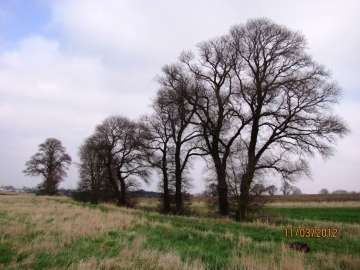Dengie Elms : This fine group of elms was photographed at Orplands Managed Retreat, Bradwell this week. Many trees such as these along the coastal fringe of the peninsular have survived the ravages of Dutch Elm Disease and sights like this are not uncommon there. They are the Small-leaved or East Anglian Elm
Ulmus minor ssp. minor, a species that is thought to have been introduced into Britain from southern Europe during the Bronze Age. One theory for the resistance to disease of this species (compared with the English Elm
Ulmus procera, mature trees of which have been all but wiped out) is that because they are outside their normal range and grow more slowly in our colder climate the spring-wood vessels in the twigs are smaller than usual and restrictive to the spread of the fungus that would kill them. It has also been mooted that the pendulous twigs on this species are unattractive to the beetle that spreads the fungus. Research has also indicated that the surviving trees may be hybrids and this too could be linked to their survival. During the past two decades over 2000 clones have been produced my micro propagation, in large part thanks to the efforts of an Essex nurseryman, Roy King, and these are now 12-15 years old and being sold for planting, for which information I am indebted to the Wikkipedia site! I hope the project succeeds as the cascades of bare twigs in winter and green foliage in summer are a wonderful spectacle.

On a gloomier note, I have now got my eye in for signs of Acute Oak Decline and am beginning to see it everywhere, Thrift Wood EWT Reserve, Bicnacre and Stoneymore Wood, Mill Green being two new sites found this week. It seems to attack relatively young oaks that are packed together in almost plantation like densities and have perhaps become stressed due to a water shortage during the recent dry years.
Spring seems to have been on hold this week with three cold, damp days and little sign of the sun on the remainder, apart from Saturday, when the first Chiffchaff of my spring - having returned from his Spanish hols - was singing his approval of the Mill Green site where Rob Smith and myself have been working this winter. The lambs-tail catkins of Aspen are now in full flower and the first Blackthorn blooms appeared this week, so the amount of pollen and nectar available to insects is steadily increasing for when the sun returneth.
























